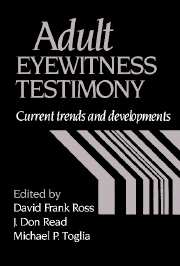Book contents
- Frontmatter
- Contents
- List of contributors
- Preface
- Part I Cognitive, physical and social processes and factors influencing eyewitness recall and identification
- 1 Reports of suggested memories: Do people truly believe them?
- 2 Memory source monitoring and eyewitness testimony
- 3 Understanding bystander misidentifications: The role of familiarity and contextual knowledge
- 4 Unconscious transference and lineup identification: Toward a memory blending approach
- 5 Earwitness evidence: Memory for a perpetrator's voice
- 6 Whole body information: Its relevance to eyewitnesses
- 7 Actual victims and witnesses to robbery and fraud: An archival analysis
- Part II Lineup construction and collection of testimony
- Part III Whom to believe? Distinguishing accurate from inaccurate eyewitnesses
- Name index
- Subject index
7 - Actual victims and witnesses to robbery and fraud: An archival analysis
Published online by Cambridge University Press: 04 August 2010
- Frontmatter
- Contents
- List of contributors
- Preface
- Part I Cognitive, physical and social processes and factors influencing eyewitness recall and identification
- 1 Reports of suggested memories: Do people truly believe them?
- 2 Memory source monitoring and eyewitness testimony
- 3 Understanding bystander misidentifications: The role of familiarity and contextual knowledge
- 4 Unconscious transference and lineup identification: Toward a memory blending approach
- 5 Earwitness evidence: Memory for a perpetrator's voice
- 6 Whole body information: Its relevance to eyewitnesses
- 7 Actual victims and witnesses to robbery and fraud: An archival analysis
- Part II Lineup construction and collection of testimony
- Part III Whom to believe? Distinguishing accurate from inaccurate eyewitnesses
- Name index
- Subject index
Summary
Although there are some exceptions (for example, Cutshall & Yuille, 1989; Fisher, Geiselman, & Amador, 1989; Read, Tollestrup, Hammersley, McFadzen, & Christensen, 1990; Sporer, 1992; Yuille & Cutshall, 1986) most of the research in the field of eyewitness memory has been laboratory based. This overreliance on laboratory research has left the field open to challenges of the external validity of the research (for example, McCloskey & Egeth, 1983; McKenna, Treadway, & McCloskey, 1992; Yuille & Wells, 1991) and has led to the recognition of a need for more diverse methods of learning about eyewitness memory (for example, Davies, 1990; Yuille & Wells, 1991). In response to this deficit of diversity, this chapter reports the results of an inquiry into actual police case files. We realize that file research lacks the experimental control of laboratory studies. Our data from police case files, however, represent a degree of realism and a range of variables impossible to simulate in a laboratory setting. We are able to provide information on a number of important topics such as the characteristics of actual eyewitnesses, the amount of detail in eyewitnesses’ descriptions of suspects, the accuracy of these descriptions, types of identification tasks employed, the prevalence and accuracy of eyewitness identification, and the weapon focus effect. We believe that the discrepancies and similarities between our results and laboratory research will be informative and serve to point out instances when research conducted in one context can apply in another.
The laboratory context has customarily cast eyewitnesses into a uniform role (Yuille & Tollestrup, in press).
- Type
- Chapter
- Information
- Adult Eyewitness TestimonyCurrent Trends and Developments, pp. 144 - 160Publisher: Cambridge University PressPrint publication year: 1994
- 52
- Cited by

